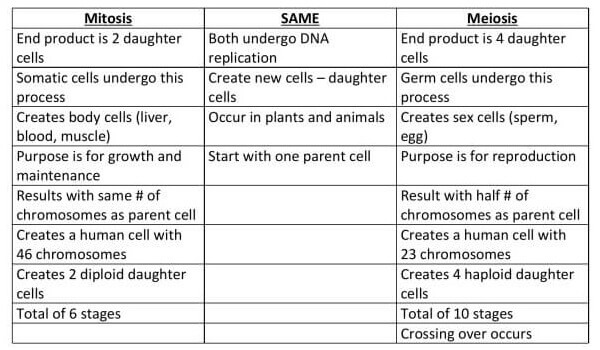Difference between mitosis and meiosis
I’m writing an essay for my living environment teacher. And I need to compare and contrast mitosis and meiosis. Can anyone help me out with this one please!!
5 Answers
-
The main differences between mitosis and meiosis:
- Mitosis has only one round of cell division, while meiosis has two.
- Mitosis only occurs in somatic cells, while meiosis occurs in sex cells.
- Mitosis produces daughter cells that are identical to the parent cell, while meiosis produces haploid/monoploid cells that only have half of the normal number of chromosomes.
The similarities between mitosis and meiosis:
- Both meiosis and mitosis are types of cell division.
- Both meiosis and mitosis produce daughter cells.
- Both meiosis and mitosis have the “PMAT” stages (which stand for Prophase, Metaphase, Anaphase and Telophase).
-
Whilst the process of meiosis bears a number of similarities with the ‘life-cycle’ cell division process of mitosis, it differs in two important respects:
- the chromosomes in meiosis undergo a recombination which shuffles the genes producing a different genetic combination in each gamete, compared with the co-existence of each of the two separate pairs of each chromosome (one received from each parent) in each cell which results from mitosis.
- the outcome of meiosis is four (genetically unique) haploid cells, compared with the two (genetically identical) diploid cells produced from mitosis.
Meiosis uses many of the same mechanisms as mitosis, a type of cell division used by eukaryotes like plants and animals to split one cell into two identical daughter cells.
Because meiosis is a “one-way” process, it cannot be said to engage in a cell cycle as mitosis does. However, the preparatory steps that lead up to meiosis are identical in pattern and name to the interphase of the mitotic cell cycle.
There are four novel steps needed in meiosis that are not present in mitosis. These are:
- pairing of homologous chromosomes;
- extensive recombination between homologs;
- suppression of sister chromatid separation in the first meiotic division;
- avoiding chromosome replication during the second meiotic division.
Meiosis is distinct from mitosis in that a central feature of meiosis is the alignment of homologous chromosomes followed by recombination between them. The two chromosomes which pair are referred to as non-sister chromosomes, since they did not arise simply from the replication of a parental chromosome. Recombination between non-sister chromosomes at meiosis is known to be a recombinational repair process that can repair double-strand breaks and other types of double-strand damage. In contrast, recombination between sister chromosomes cannot repair double-strand damages arising prior to the replication which produced them. Thus on this view, the adaptive advantage of meiosis is that it facilitates recombinational repair of DNA damages that are otherwise difficult to repair, and that occur as a result of stress, particularly oxidative stress. If left unrepaired, these damages would likely be lethal to gametes and inhibit production of viable progeny.
-
Mitosis vs Meiosis Venn Diagram

-
Differences Mitosis Meiosis Centromeres Split The centromeres split during anaphase. The centromeres do not separate during anaphase I, but during anaphase II. Chiasmata Absent Observed during prophase I and metaphase I. Chromosome Number Remains the same. Reduced by half. Chromosomes Pairing Does Not Occur Takes place during zygotene of prophase I and continue upto metaphase I. Creates Makes everything other than sex cells. Sex cells only: female egg cells or male sperm cells. Crossing Over No, crossing over cannot occur. Yes, mixing of chromosomes can occur. Cytokinesis Occurs in Telophase. Occurs in Telophase I and in Telophase II. Discovered by Walther Flemming Oscar Hertwig Exchange of Segments Two chromatids of a chromosome do not exchange segments during prophase. Chromatids of two homologous chromosome exchange segments during crossing over. Function Cellular reproduction and general growth and repair of the body. Genetic diversity through sexual reproduction. Function Takes part in healing and repair. Takes part in the formation of gametes and maintenance of chromosome number. Genetically Similar Different Karyokinesis Occurs in Interphase. Occurs in Interphase I. Mother Cells Can be either haploid or diploid Always diploid Nucleoli Reappear at telophase Do not reappear at telophase I. Number of Daughter Cells produced 2 diploid cells 4 haploid cells Number of Divisions One Two Pairing of Homologs No Yes Prophase Simple Complicated Prophase Duration of prophase is short, usually of few hours. Prophase is comparatively longer and may take days. Spindle Fibres Disappear completely in telophase. Do not disappear completely in telophase I. Steps Prophase, Metaphase, Anaphase, Telophase. (Meiosis 1) Prophase I, Metaphase I, Anaphase I, Telophase I; (Meiosis 2) Prophase II, Metaphase II, Anaphase II and Telophase II. Synapsis No Synapsis Synapsis of Homologous chromosomes takes place during prophase. Takes Place in Somatic Cells Germ Cells Type of Reproduction Asexual Sexual
-
Compare and contrast mitosis and meiosis essay sample


